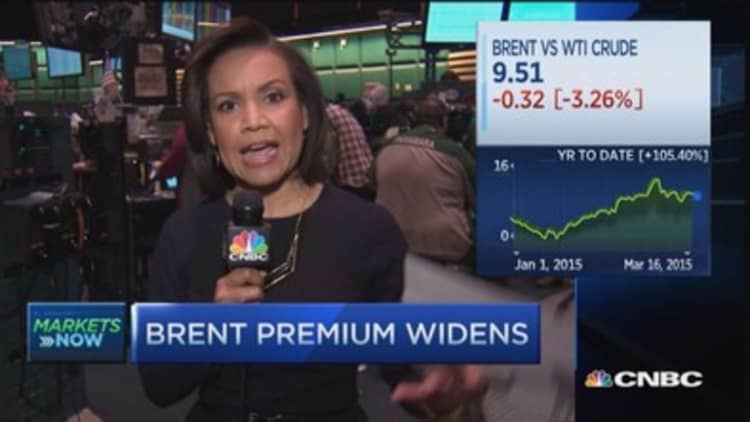Wall Street is giving five big reasons for why the price of oil is headed lower. You may have heard two but at least two are surprising.
First reason is the Cushing, Oklahoma, storage dilemma.
Oil companies have been storing oil in tanks at Cushing, which is the main hub for WTI crude, in order to not add new supply and kick a fragile market while it is down. But they can only do that for so long, and now the Cushing tanks have hit record levels. Citigroup believes that Cushing will hit maximum storage levels in a few weeks.
"Storage levels at Cushing are reaching tank tops which the oil market will have to clear, but most likely at crude breaking below $30/WTI barrel," the Citi report said. "The crude has to end up somewhere likely pressuring prices."
The second is a surprising one. Iranian crude could flood the market.

Negotiations between Iran and the U.S. over the Middle Eastern country's nuclear program will intensify this week with the goal of an agreement by the end of the month. Some sanctions could be lifted as a way to move Iran toward dropping its nuclear ambitions and that could mean an increasing amount of Iranian crude hitting the market.
"Our view is that if the market is looking for a trigger for its next fundamental move downward, the perception of sanctions relief could pave the way," Barclays' Michael Cohen wrote in a note Monday. "The prospect of an increase in Iranian oil sales as part of a new agreement in the next couple of months will only exacerbate OPEC oversupply to the market, as well as raise additional uncertainty about the timing of such oil sales increasing."
Because of this possibility, Barclays sees WTI crude falling to $39 a barrel over the next three months.
Read More 'Fracklog' means no oil bottom anytime soon
The third reason is the trend around the world for countries like Mexico and Brazil opening up their oil resources to be exported and not just for national interests.
A Cowen & Co. report said:
"Brazil is the 7th largest oil consumer and the 13th largest oil producer in the world. Historically, the production growth story has been favorable. With the exception of 2012 and 2013, Brazil has increased oil/gas production every year since 1991. Since year 2000, Brazil's oil production has grown by over 800 MBD (million barrels per day) or 66 percent."
The fourth reason is a breakdown on the oil price chart.
Sunday night, the price of WTI broke below a low in January that formed a key double bottom that held for almost two months. Now that that is gone, short-term weakness can be expected.
Brean Capital's Roberto Friedlander believes there will be a "washout" to the very low 40s before a bottom and then it should go higher from there.
And the last reason should be familiar: the U.S. dollar.
A rise in the dollar nearly always hits commodities. Other than supply figures, the dollar is the second-biggest reason for the price being cut in half. The Federal Reserve on Wednesday will give its decision on interest rates and if the central bank paves the way for a summer rate increase by dropping the word "patience" from its formal statement—as many expect—the dollar should continue its relentless march higher.
The money play:
If you agree with this analysis, there is an exchange traded fund that allows you to bet against oil without using options or a fancy brokerage account.
The DB Crude Oil Double Short ETN provides the inverse return of WTI on the day.






